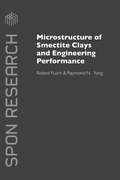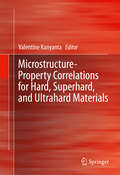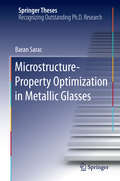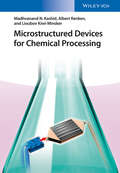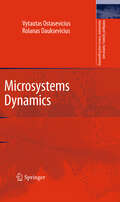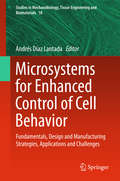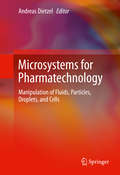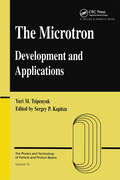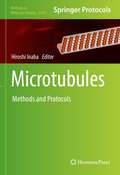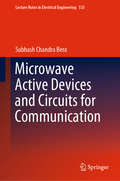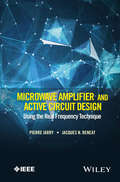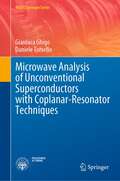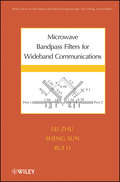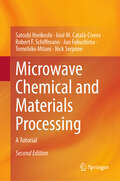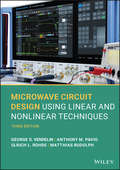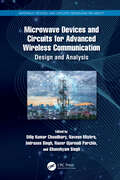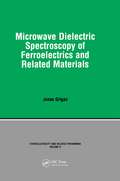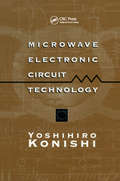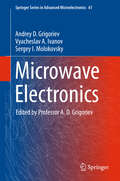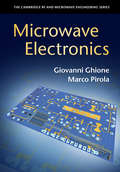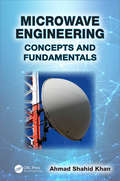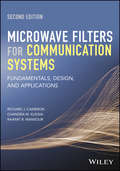- Table View
- List View
Microstructure of Metals and Alloys: An Atlas of Transmission Electron Microscopy Images
by Ganka Zlateva Zlatanka MartinovaA teaching tool intended to complement existing books on the theory of materials science, metallurgy, and electron microscopy, this text focuses on metals and alloys. It visualizes key structural elements common to crystalline materials, including crystal lattice imperfections, along with the principles and steps involved in the microstructure deve
Microstructure of Smectite Clays and Engineering Performance
by Raymond N. Yong Roland PuschCertain wastes such as nuclear wastes, are so hazardous that their disposal creates a major challenge requiring considerable technical skill and understanding. Their effective isolation in the ground depends on the properties of the surrounding clays. This authoritative book explains the detailed function of clay-based engineered barriers, gives a
Microstructure-Property Correlations for Hard, Superhard, and Ultrahard Materials
by Valentine KanyantaThis book discusses microstructure-property correlations and explores key microstructure features and how they affect the properties of a material. The authors discuss the effect of manufacturing and processing routes on microstructure and properties. They identify appropriate microstructure and mechanical characterization techniques essential for developing accurate microstructure-property relationships. The techniques include high resolution imaging methods and properties measurements such as hardness, strength, elastic modulus, and fracture toughness. Current and future trends in hard and superhard material design are revealed by the authors, including nanostructured materials, biomimicry, and novel manufacturing technologies.
Microstructure-Property Optimization in Metallic Glasses
by Baran SaracThis thesis consists of an in-depth study of investigating microstructure-property relationships in bulk metallic glasses using a novel quantitative approach by which influence of the second phase features on mechanical properties can be independently and systematically analyzed. The author evaluates and optimizes the elastic and plastic deformation, as well as the overall toughness of cellular honeycombs under in-plane compression and porous heterostructures under uniaxial tension. The study reveals three major deformation zones in cellular metallic glass structures, where deformation changes from collective buckling showing non-linear elasticity to localized failure exhibiting a brittle-like deformation, and finally to global sudden failure with negligible plasticity as the length to thickness ratio of the ligaments increases. The author found that spacing and size of the pores, the pore configuration within the matrix, and the overall width of the sample determines the extent of deformation, where the optimized values are attained for pore diameter to spacing ratio of one with AB type pore stacking.
Microstructured Devices for Chemical Processing
by Madhvanand N. Kashid Lioubov Kiwi-Minsker Albert RenkenBased on courses taught by the authors, this advanced textbook discusses opportunities for achieving larger-scale reactions in a technically controllable, sustainable, cost-effective and safe manner. Adopting a practical approach, it describes how miniaturized devices are used successfully for process intensification, focusing on the engineering aspects of microstructured devices, such as their design and characterization for homogeneous and multiphase reactions. It addresses the conditions under which microstructured devices are beneficial, how they should be designed, and how such devices can be integrated in a chemical process. Essential for master and doctoral students, as well as professional chemists and chemical engineers working in this area.
Microstructured Materials: Inverse Problems
by Jüri Engelbrecht Jaan JannoComplex, microstructured materials are widely used in industry and technology and include alloys, ceramics and composites. Focusing on non-destructive evaluation (NDE), this book explores in detail the mathematical modeling and inverse problems encountered when using ultrasound to investigate heterogeneous microstructured materials. The outstanding features of the text are firstly, a clear description of both linear and nonlinear mathematical models derived for modelling the propagation of ultrasonic deformation waves, and secondly, the provision of solutions to the corresponding inverse problems that determine the physical parameters of the models. The data are related to nonlinearities at both a macro- and micro- level, as well as to dispersion. The authors' goal has been to construct algorithms that allow us to determine the parameters within which we are required to characterize microstructure. To achieve this, the authors not only use conventional harmonic waves, but also propose a novel methodology based on using solitary waves in NDE. The book analyzes the uniqueness and stability of the solutions, in addition to providing numerical examples.
Microsystems Dynamics
by Vytautas Ostasevicius Rolanas DaukseviciusIn recent years microelectromechanical systems (MEMS) have emerged as a new technology with enormous application potential. MEMS manufacturing techniques are essentially the same as those used in the semiconductor industry, therefore they can be produced in large quantities at low cost. The added benefits of lightweight, miniature size and low energy consumption make MEMS commercialization very attractive. Modeling and simulation is an indispensable tool in the process of studying these new dynamic phenomena, development of new microdevices and improvement of the existing designs. MEMS technology is inherently multidisciplinary since operation of microdevices involves interaction of several energy domains of different physical nature, for example, mechanical, fluidic and electric forces. Dynamic behavior of contact-type electrostatic microactuators, such as a microswitches, is determined by nonlinear fluidic-structural, electrostatic-structural and vibro-impact interactions. The latter is particularly important: Therefore it is crucial to develop accurate computational models for numerical analysis of the aforementioned interactions in order to better understand coupled-field effects, study important system dynamic characteristics and thereby formulate guidelines for the development of more reliable microdevices with enhanced performance, reliability and functionality.
Microsystems for Enhanced Control of Cell Behavior
by Andrés Díaz LantadaThis handbook focuses on the entire development process of biomedical microsystems that promote special interactions with cells. Fundamentals of cell biology and mechanobiology are described as necessary preparatory input for design tasks. Advanced design, simulation, and micro/nanomanufacturing resources, whose combined use enables the development of biomedical microsystems capable of interacting at a cellular level, are covered in depth. A detailed series of chapters is then devoted to applications based on microsystems that offer enhanced cellular control, including microfluidic devices for diagnosis and therapy, cell-based sensors and actuators (smart biodevices), microstructured prostheses for improvement of biocompatibility, microstructured and microtextured cell culture matrices for promotion of cell growth and differentiation, electrophoretic microsystems for study of cell mechanics, microstructured and microtextured biodevices for study of cell adhesion and dynamics, and biomimetic microsystems (including organs-on-chips), among others. Challenges relating to the development of reliable in vitro biomimetic microsystems, the design and manufacture of complex geometries, and biofabrication are also discussed.
Microsystems for Pharmatechnology
by Andreas DietzelThis book provides a comprehensive, state-of-the-art review of microfluidic approaches and applications in pharmatechnology. It is appropriate for students with an interdisciplinary interest in both the pharmaceutical and engineering fields, as well as process developers and scientists in the pharmaceutical industry. The authors cover new and advanced technologies for screening, production by micro reaction technology and micro bioreactors, small-scale processing of drug formulations, and drug delivery that will meet the need for fast and effective screening methods for drugs in different formulations, as well as the production of drugs in very small volumes. Readers will find detailed chapters on the materials and techniques for fabrication of microfluidic devices, microbioreactors, microsystems for emulsification, on-chip fabrication of drug delivery systems, respiratory drug delivery and delivery through microneedles, organs-on-chip, and more.
Microtexture Determination and Its Applications
by V. RandleA cornerstone in the study of both natural and technological materials is characterisation of microstructure. In the widest sense this topic encompasses, for all phases present: morphology, including size and shape distributions; chemical composition; crystallographic parameters, including orientation and orientation relationships. A landmark advance for the materials community occurred with the genesis of 'microtexture', which for the first time provided integration of crystallographic parameters and other aspects of the microstructure. A definition of microtexture is: 'a population of crystallographic orientations whose individual components are linked to their location within the microstructure.' The term microtexture also describes any experimental technique used to determine this information. Essentially, a stationary beam of electrons is diffracted by atomic planes in the sampled volume of specimen. Analysis of the resulting diffraction pattern provides crystallographic information which can be related back to its position of origin. An estimated 95 percent of microtexture determination is by 'electron backscatter diffraction' (EBSD) in a scanning electron microscope (SEM), with the remaining 5 percent contributed mainly by transmission electron microscopy (TEM) counterparts to EBSD. Evaluation (indexing) of EBSD diffraction patterns and output of data in a variety of formats is in most cases fully automated. The most exciting EBSD output is an 'orientation map', which is a quantitative depiction of the microstructure in terms of its orientation constituents. Microtexture determination is now firmly established as the most comprehensive experimental tool for quantitative characterisation and analysis of microstructure, and is used extensively in both research and industry. Much has changed since this book was first published and the second edition has been completely rewritten to reflect these changes.
Microtron: Development and Applications
by Yuri M. TsipenyukThe Microtron: Development and Applications is a comprehensive monograph that sums up more than 30 years of research and development in microtron technology and applications and provides a systematic presentation of results from investigations carried out in Russia and abroad. The first part describes the basic principles of various types of microt
Microtubules: Methods and Protocols (Methods in Molecular Biology #2430)
by Hiroshi InabaThis volume provides state-of-the-art methodology to functionalize microtubules and construct microtubule-based materials. Chapters consists of six sections detailing modification of microtubule structures, observation and control of microtubule movement, material applications of microtubules in vitro, development of microtubule-binding molecules, comprehensive approaches to analyze properties of microtubules, and functionalization of microtubules in living cells. Written in the highly successful Methods in Molecular Biology series format, chapters include introductions to their respective topics, lists of the necessary materials and reagents, step-by-step, readily reproducible laboratory protocols, and tips on troubleshooting and avoiding known pitfalls. Authoritative and cutting-edge, Microtubules: Methods and Protocols aims to provide useful information for construction of microtubule-based materials and help to create new ideas for the next-generation of materials and applications through detailed protocols.
Microwave Active Devices and Circuits for Communication (Lecture Notes in Electrical Engineering #533)
by Subhash Chandra BeraThe book discusses active devices and circuits for microwave communications. It begins with the basics of device physics and then explores the design of microwave communication systems including analysis and the implementation of different circuits. In addition to classic topics in microwave active devices, such as p-i-n diodes, Schottky diodes, step recovery diodes, BJT, HBT, MESFET, HFET, and various microwave circuits like switch, phase shifter, attenuator, detector, amplifier, multiplier and mixer, the book also covers modern areas such as Class-F power amplifiers, direct frequency modulators, linearizers, and equalizers. Most of the examples are based on practical devices available in commercial markets and the circuits presented are operational. The book uses analytical methods to derive values of circuit components without the need for any circuit design tools, in order to explain the theory of the circuits. All the given analytical expressions are also cross verified using commercially available microwave circuit design tools, and each chapter includes relevant diagrams and solved problems. It is intended for scholars in the field of electronics and communication engineering.
Microwave Amplifier and Active Circuit Design Using the Real Frequency Technique
by Pierre Jarry Jacques N. BeneatDescribes the use of the Real Frequency Technique for designing and realizing RF/microwave amplifiers and circuits This book focuses on the authors' Real Frequency Technique (RFT) and its application to a wide variety of multi-stage microwave amplifiers and active filters, and passive equalizers for radar pulse shaping and antenna return loss applications. The first two chapters review the fundamentals of microwave amplifier design and provide a description of the RFT. Each subsequent chapter introduces a new type of amplifier or circuit design, reviews its design problems, and explains how the RFT can be adapted to solve these problems. The authors take a practical approach by summarizing the design steps and giving numerous examples of amplifier realizations and measured responses. Provides a complete description of the RFT as it is first used to design multistage lumped amplifiers using a progressive optimization of the equalizers, leading to a small number of parameters to optimize simultaneously Presents modifications to the RFT to design trans-impedance microwave amplifiers that are used for photodiodes acting as high impedance current sources Discusses the methods using the RFT to optimize equalizers made of lossy distributed networks Covers methods and examples for designing standard linear multi-stage power amplifiers and those using arborescent structures Describes how to use the RFT to design multi?]stage active filters Shows the flexibility of the RFT to solve a variety of microwave circuit design problems like the problem of passive equalizer design for Radar receivers Examines a possible method for the synthesis of microwave antennas using the RFT Microwave Amplifier and Active Circuit Design Using the Real Frequency Technique is intended for researchers and RF and microwave engineers but is also suitable for advanced graduate students in circuit design. Dr. Beneat and Dr. Jarry are members of the editorial board of Wiley's International Journal of RF and Microwave Computer Aided Engineering. They have published seven books together, including Advanced Design Techniques and Realizations of Microwave and RF Filters (Wiley-IEEE 2008), Design and Realizations of Miniaturized Fractals RF and Microwave Filters (Wiley 2009), Miniaturized Microwave Fractal Filters--M2F2 (Wiley 2012), and RF and Microwave Electromagnetism (Wiley-ISTE 2014).
Microwave Analysis of Unconventional Superconductors with Coplanar-Resonator Techniques (PoliTO Springer Series)
by Gianluca Ghigo Daniele TorselloThis book provides a thorough overview of methods and approaches to the experimental characterization of superconductors at microwave frequencies, and includes a detailed description of the two main techniques, both based on the use of coplanar waveguide resonators, that the authors employed to investigate the properties of unconventional superconductors. In the second part several case studies are described, covering a large spectrum of materials and issues. Particular emphasis is given to recent hot topics concerning iron-based superconductors, both of fundamental nature and relevant for applications. The book is intended as a learning tool for researchers in the field, and serves as a guide providing inspiring examples of the use of coplanar resonator techniques to address key topics in the field of unconventional superconductivity.
Microwave Bandpass Filters for Wideband Communications
by Rui Li Sheng Sun Lei ZhuThis book will appeal to scientists and engineers who are concerned with the design of microwave wideband devices and systems. For advanced (ultra)-wideband wireless systems, the necessity and design methodology of wideband filters will be discussed with reference to the inherent limitation in fractional bandwidth of classical bandpass filters. Besides the detailed working principles, a large number of design examples are demonstrated, which can be easily followed and modified by the readers to achieve their own desired specifications. Therefore, this book is of interest not only to students and researchers from academia, but also to design engineers in industry. With the help of complete design procedures and tabulated design parameters, even those with little filter design experience, will find this book to be a useful design guideline and reference, which can free them from tedious computer-aided full-wave electromagnetic simulations. Among different design proposals, wideband bandpass filters based on the multi-mode resonator have demonstrated many unparalleled attractive features, including a simple design methodology, compact size, low loss and good linearity in the wide passband, enhanced out-of-band rejection, and easy integration with other circuits/antennas. A conventional bandpass filter works under single dominant resonant modes of a few cascaded transmission line resonators and its operating bandwidth is widened via enhanced coupling between the adjacent resonators. However, this traditional approach needs an extremely high coupling degree of coupled-lines while producing a narrow upper stopband between the dominant and harmonic bands. As a sequence, the desired dominant passband is restricted to an extent less than 60% in fractional bandwidth. To circumvent these issues and break with the tradition, a filter based on the multiple resonant modes was initially introduced in 2000 by the first author of this book. Based on this novel concept, a new class of wideband filters with fractional bandwidths larger than 60% has been successfully developed so far. This book, presents and characterizes a variety of multi-mode resonators with stepped-impedance or loaded-stub configurations using the matured transmission line theory for development of advanced microwave wideband filters.
Microwave Chemical and Materials Processing: A Tutorial
by Nick Serpone Satoshi Horikoshi Robert F. Schiffmann Jun Fukushima José M. Catalá-Civera Tomohiko MitaniThis book adds remarkable advances in microwave chemistry, methods, equipment, and practical examples since the first edition was published in 2018. Moreover, practical examples of the use of microwave energy have been upgraded. It also includes how to easily predict microwave heating using material constants. In addition, coupling analysis simulation with electromagnetic fields and heat transfer which greatly support researchers' experiments is covered. The principal aim of this book hasn’t changed: to introduce chemists through a tutorial approach to the use of microwaves by examining several experiments of microwave chemistry and materials processing. It subsequently enables chemists to fashion their own experiments in microwave chemistry or materials processing. This book helps chemists who take an interest in the use of microwave radiation to overcome difficulties to understand the nature of electromagnetism, microwave engineering, and thermodynamics.
Microwave Circuit Design Using Linear and Nonlinear Techniques
by Ulrich L. Rohde Matthias Rudolph George D. Vendelin Anthony M. PavioFour leaders in the field of microwave circuit design share their newest insights into the latest aspects of the technology The third edition of Microwave Circuit Design Using Linear and Nonlinear Techniques delivers an insightful and complete analysis of microwave circuit design, from their intrinsic and circuit properties to circuit design techniques for maximizing performance in communication and radar systems. This new edition retains what remains relevant from previous editions of this celebrated book and adds brand-new content on CMOS technology, GaN, SiC, frequency range, and feedback power amplifiers in the millimeter range region. The third edition contains over 200 pages of new material. The distinguished engineers, academics, and authors emphasize the commercial applications in telecommunications and cover all aspects of transistor technology. Software tools for design and microwave circuits are included as an accompaniment to the book. In addition to information about small and large-signal amplifier design and power amplifier design, readers will benefit from the book’s treatment of a wide variety of topics, like: An in-depth discussion of the foundations of RF and microwave systems, including Maxwell’s equations, applications of the technology, analog and digital requirements, and elementary definitions A treatment of lumped and distributed elements, including a discussion of the parasitic effects on lumped elements Descriptions of active devices, including diodes, microwave transistors, heterojunction bipolar transistors, and microwave FET Two-port networks, including S-Parameters from SPICE analysis and the derivation of transducer power gain Perfect for microwave integrated circuit designers, the third edition of Microwave Circuit Design Using Linear and Nonlinear Techniques also has a place on the bookshelves of electrical engineering researchers and graduate students. It’s comprehensive take on all aspects of transistors by world-renowned experts in the field places this book at the vanguard of microwave circuit design research.
Microwave Devices and Circuits for Advanced Wireless Communication: Design and Analysis (Materials, Devices, and Circuits)
by Ghanshyam Singh Indrasen Singh Dilip Kumar Choudhary Naveen Mishra Naser Ojaroudi ParchinThis book offers a comprehensive overview of design and analysis of microwave devices and circuits for 5G and beyond wireless communication systems. It focuses on modern microwave antennas, filters, metamaterials, and MIMO systems. It includes a design approach based on Artificial Intelligence and the practical use of microwave devices and circuits in commercial, medical, and military applications.Microwave Devices and Circuits for Advanced Wireless Communications: Design and Analysis explores the performance of microwave devices and circuits by highlighting the difficulties encountered by researchers and designers such as latency, interoperability, wireless coexistence, data streaming, safety, security, and privacy. The book explores the most important aspects of antenna design, including radiation pattern control, impedance matching with bandwidth improvement, and gain enhancement. It also examines different categories of metasurfaces, including frequency-selective surfaces (FSS) and electromagnetic bandgap (EBG) structures, and their distinct roles in antenna design. Additionally, the book examines concepts such as ultra-wideband (UWB) radar for 5G millimeter wave applications, and advanced techniques such as synthetic aperture radar (SAR), beam-forming, compressed sensing, and diffraction tomography for enabling high-resolution imaging across wider application areas. The authors also present an overview on applying machine learning (ML) techniques to advanced wireless communication for signal-processing tasks such as signal denoising, equalization, and modulation recognition. They then discuss the potential significance of UAV communication systems in achieving seamless connection, quality of service (QoS), as well as the difficulties and potential remedies involved in building dependable networks using UAVs. Throughout the book the authors offer a critical assessment of the strengths and limitations of each topic and approach presented, thus providing valuable guidance for future research in this exciting field.This book will be helpful for graduate students, researchers, and engineers working in the area of design and reliability of circuits for microwave and communication systems.
Microwave Dielectric Spectroscopy of Ferroelectrics and Related Materials
by Jonas GrigasIn this important book, the author summarizes and generalizes the results of 25 years of work in this exciting field, which has been developing extensively within the last few decades. The reader will find discussions of many crystals that were investigated in the microwave region, including low-dimensional and ferroelectric semiconductors, protonic conductors, quasi-one-dimensional H-bonded. and other order-disorder ferroelectrics. This volume is an essential reference for all scientists and graduate students whose interests are connected to the physics of ferroelectrics and related materials; the physics of structural phase transitions; and superionic conductors. It will also be of value to those interested in developing or exploiting microwave measurement techniques.
Microwave Electronic Circuit Technology
by Yoshihiro KonishiProvides a grounding in the physics behind the operational principles of high frequency technologies. The text presents up-to-date methods, as well as the research and developments of more efficient devices for use in applications, from mobile and satellite communications and wireless Local Area Networks to energy transformation and sensors. Examples and theories support the material.
Microwave Electronics
by Andrey D. Grigoriev Vyacheslav A. Ivanov Sergey I. MolokovskyThis book describes the physical basis of microwave electronics and related topics, such as microwave vacuum and microwave semiconductor devices.It comprehensively discusses the main types of microwave vacuum and microwave semiconductor devices, their principles of action, theory, parameters and characteristics, as well as ways of increasing the frequency limit of various devices up to the terahertz frequency band. Further, it applies a unified approach to describe charged particle interaction within electromagnetic fields and the motion laws of charged particles in various media. The book is intended as a manual for researchers and engineers, as well as advanced undergraduate and graduate students.
Microwave Electronics (The Cambridge RF and Microwave Engineering Series)
by Giovanni Ghione Marco PirolaDrawing on over twenty years of teaching experience, this comprehensive yet self-contained text provides an in-depth introduction to the field of integrated microwave electronics. Ideal for a first course on the subject, it covers essential topics such as passive components and transistors, linear, low-noise and power amplifiers, and microwave measurements. An entire chapter is devoted to CAD techniques for analysis and design, covering examples of easy-to-medium difficulty for both linear and non-linear subsystems, and supported online by ADS and AWR project files. More advanced topics are also covered, providing an up-to-date overview of compound semiconductor technologies and treatment of electromagnetic issues and models. Readers can test their knowledge with end-of-chapter questions and numerical problems, and solutions and lecture slides are available online for instructors. This is essential reading for graduate and senior undergraduate students taking courses in microwave, radio-frequency and high-frequency electronics, as well as professional microwave engineers.
Microwave Engineering: Concepts and Fundamentals
by Ahmad Shahid KhanDetailing the active and passive aspects of microwaves, Microwave Engineering: Concepts and Fundamentals covers everything from wave propagation to reflection and refraction, guided waves, and transmission lines, providing a comprehensive understanding of the underlying principles at the core of microwave engineering. This encyclopedic text not onl
Microwave Filters for Communication Systems: Fundamentals, Design, and Applications
by Richard J. Cameron Chandra M. Kudsia Raafat R. MansourAn in-depth look at the state-of-the-art in microwave filter design, implementation, and optimization Thoroughly revised and expanded, this second edition of the popular reference addresses the many important advances that have taken place in the field since the publication of the first edition and includes new chapters on Multiband Filters, Tunable Filters and a chapter devoted to Practical Considerations and Examples. One of the chief constraints in the evolution of wireless communication systems is the scarcity of the available frequency spectrum, thus making frequency spectrum a primary resource to be judiciously shared and optimally utilized. This fundamental limitation, along with atmospheric conditions and interference have long been drivers of intense research and development in the fields of signal processing and filter networks, the two technologies that govern the information capacity of a given frequency spectrum. Written by distinguished experts with a combined century of industrial and academic experience in the field, Microwave Filters for Communication Systems: Provides a coherent, accessible description of system requirements and constraints for microwave filters Covers fundamental considerations in the theory and design of microwave filters and the use of EM techniques to analyze and optimize filter structures Chapters on Multiband Filters and Tunable Filters address the new markets emerging for wireless communication systems and flexible satellite payloads and A chapter devoted to real-world examples and exercises that allow readers to test and fine-tune their grasp of the material covered in various chapters, in effect it provides the roadmap to develop a software laboratory, to analyze, design, and perform system level tradeoffs including EM based tolerance and sensitivity analysis for microwave filters and multiplexers for practical applications. Microwave Filters for Communication Systems provides students and practitioners alike with a solid grounding in the theoretical underpinnings of practical microwave filter and its physical realization using state-of-the-art EM-based techniques.

